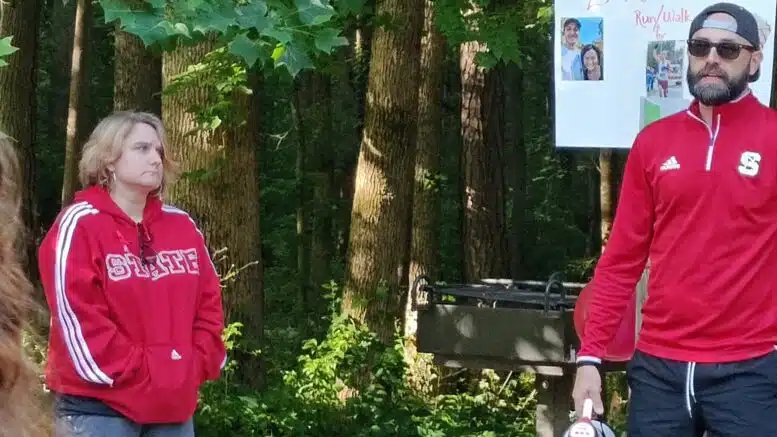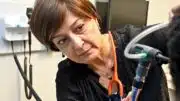By Jennifer Fernandez
Eight-year-old Miles Campbell loved to help those in need, a lesson he learned from his parents.
Their latest project, spearheaded by his mom, Susie Campbell, involved collecting items to give to homeless residents around town. Miles called them “goodie bags” and kept an eye out for anyone who might need one.
Miles died last week, shortly after his parents Susie and Tyler Campbell, who were killed in the Memorial Day car crash that also fatally injured Miles. Because he was so generous in life, and his parents were listed as organ donors, Miles’ extended family members agreed to donate his organs.
His last gift helped save the lives of four people, according to Dena Daw with HonorBridge, North Carolina’s largest federally designated organ procurement organization.
It’s what Miles and his parents would have wanted, said Kathy Campbell, Tyler’s mother.
“He would want to know he was able to save other people’s lives,” she said of her grandson.
Fewer donors
While adults make up the vast majority of organ transplants every year, children also need new organs. Some are born with conditions that put them immediately on the transplant list, Daw said.
“They’re essentially in need of a life the minute they’re born,” she said.
In North Carolina, 3,790 people were awaiting an organ transplant as of June 2, according to the United Network for Organ Sharing, the private nonprofit organization that’s contracted by the federal government to manage the nation’s organ transplant system.
Of those, just 82 are age 17 or younger.
Nonetheless, some of them will die while waiting.
Matching organs to children is harder because organ size also has to be considered: An adult-sized heart won’t fit in a child’s chest. While some adult organs can be used for children, an organ from another child often makes a better match.
That’s why there’s a huge need for children’s organs.
“Children need other children,” Daw said. “It’s sad, but that’s the truth.”
So far this year, 20 children in North Carolina have received a transplant, federal data shows. Four children have donated organs in the state as of June 2.
It’s not clear if that data includes the organs that Miles donated. Daw said his lungs went to one recipient, his left kidney and pancreas to another, his right kidney to a third recipient and his liver to a fourth.
For every donation, so much has to go right, said Joel Baucom, HonorBridge’s director of partner engagement. There are so many logistical challenges to get the organs where they need to go to save a life.
“Every time it happens, it feels like a miracle.”
Want to donate your organs?
- Anyone 18 or older can sign up at www.registerme.org, DonateLife, HonorBridge or LifeShare Carolinas.
- Anyone getting their driver’s license can sign up at that time. If you are younger than 18, you can register your intent to be an organ donor, but a parent or legal guardian would have the final say until you turn 18.
- People with iPhones can go to the health app, tap the profile photo or initials at the top right, then select organ donation. Tap on the “sign up with Donate Life” and fill out the form.
Long waits
Two years ago, the United States reached a huge milestone in organ transplantation. That year, the U.S. celebrated its one millionth transplant — the most of any country in the world.
Last year, a record 23,288 people donated an organ, according to Donate Life America.
Yet, it’s still not enough. Every eight minutes, another person in the United States is added to the transplant list.
And every year, 5,600 people in this country die waiting for an organ.
It’s not clear how many children die every year waiting for a transplant. A study on pediatric heart transplants from 2016 to 2019 showed that 250 U.S. children died while waiting for a heart. According to a more recent report, 24 U.S. children died in 2022 while waiting for a kidney transplant.
The wait for an organ can last from weeks to years — in some cases longer than five years.
“Since there are always more children and teens on the waiting list than there are organs, nearly 50% of all kids will stay on the list for a full year or longer,” pediatric critical care physician Benson Hsu wrote last year in an article for HealthyChildren.org, a publication of the American Academy of Pediatrics, to explain the organization’s policy on child organ donation.
“Some unfortunately die waiting for a life-saving organ transplant,” Hsu wrote. “Children under 1 year old face the highest death rate waiting for an organ transplant.”
Three infants (children who have yet to turn one year old) are on North Carolina’s transplant waiting list as of June 2.
No. 1 need
Most children ages 1 to 17 are waiting for kidneys, according to Donate Life America. Most children younger than 1 year are waiting for a liver or a heart.
There are also children waiting for organ donations of lung, intestine and pancreas.
While small children typically can only receive organs from another child, larger and older children can receive adult organs.
For instance, a child older than 2 can receive an adult kidney as long as it fits in their body.
About 70 percent of organs come from deceased donors, federal transplant data shows. The other 30 percent come from living donors.
Adults can be living donors by giving a kidney or part of their liver, for example, to a patient. A person can live with just one kidney, and the liver can regenerate to full size in both the donor and the recipient.
Almost one half of kidney transplants for children are from living donors, according to the American Kidney Fund.
More on organ donation
One donor can save up to eight lives through organ transplants; restore sight to two people with cornea donation; and help up to 75 people with skin and tissue donation.
Thanks to advances in medicine, people with diseases like cancer, hepatitis and HIV are now able to donate. Since 2013, the HOPE Act has provided an avenue for HIV-positive patients needing a transplant to receive an organ from an HIV-positive donor.
Only about 1 percent of people who die will be able to donate an organ. Certain conditions must be met to make organs viable for transplant, including that the death take place in the hospital and the donor must be on a ventilator.
What can be donated?
Organs: heart, kidneys, liver, lungs, pancreas, intestines
Tissues: eyes/corneas, heart valves, bone and associated tissue, skin, veins and arteries, nerve
What is a living organ donation?
A living person can donate a kidney or piece of their liver to another person. There were more than 6,900 living organ transplants last year.
After a live birth, tissue such as the placenta can also be donated. There’s no impact on the health of the mother or child. The tissue can be used in reconstructive procedures to promote healing, and to treat burns and painful wounds.
Source: LifeShare Carolinas, DonateLife America
A difficult decision
When a patient arrives at a hospital and is unlikely to survive, that starts the process of possibly donating their organs.
The hospital contacts an organ procurement organization, such as HonorBridge, which sends family support coordinators to speak with family members. In some cases, the patient may have already signed up to be an organ donor. But when there is no such designation, HonorBridge will speak with family members who are authorized to make that decision, Baucom said.
At HonorBridge, the family support coordinators all have some kind of family-oriented background. Some are chaplains or handle pastoral care at their churches; others are social workers.
“It’s essentially people who have some level of experience working with people who have experienced trauma,” Baucom said.
Adults can choose to be an organ donor before they die, and the designation appears on their driver’s licenses.
Teens can indicate their desire to donate when applying for a license, although their parents would have the final say until they reach 18.
For young children, family members face the decision at the same time as they are saying goodbye to a loved one.
Kathy Campbell said she wasn’t thinking about organ donation when Miles was brought to the hospital after the crash that killed his parents. She was just “praying for him to wake up.”
She doesn’t remember who, but someone brought up the topic of organ donation. Then the family spoke with a nurse, who connected them to HonorBridge, she said.
She said both sets of grandparents, along with Tim and Kayla Sasser (who would have been guardians to Miles had he lived) discussed organ donation before making the decision.
“It was one of the most encouraging and affirming decisions that we made,” Tim Sasser said Saturday, June 1, during a memorial run/walk for Miles and his family at White Deer Park in Garner.
‘To help people’
Dozens of people attended the event wearing red shirts to honor the family and its deep connection to N.C. State. Tyler and Susie graduated from the university, where they met the Sassers during their freshman year.
Among the participants was fellow nurse Kathyrn Redmond of Graham, who worked with Susie Campbell at UNC Medical Center in Chapel Hill. She said Miles being able to help others through organ donation offers some consolation about what happened, and it reflects how his mother approached life.
“That’s why we became nurses, to help people,” she said.
Miles’ generosity doesn’t end with the four lives saved by his donated organs. His heart was also donated to research.
For a lot of donor families, the knowledge that their loved one lives on in others can help them manage their grief, Baucom said.
“Organ donation presents this really unique opportunity for a little bit of light, or a little bit of hope in a really dark place,” he said. “Because you know that there’s a legacy and that the life and the love didn’t stop there with that death.”












